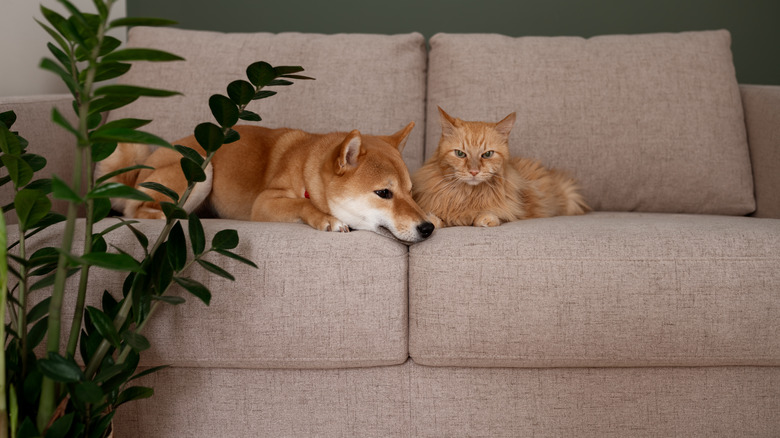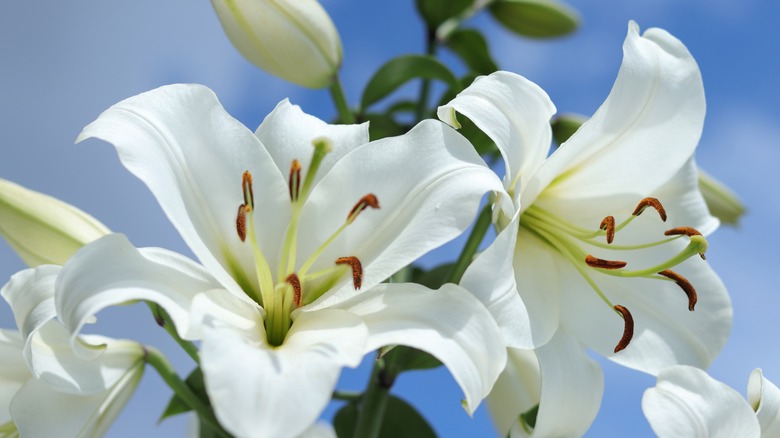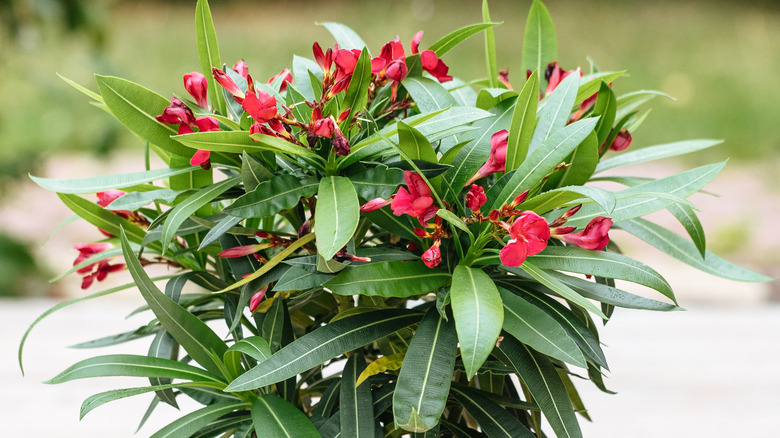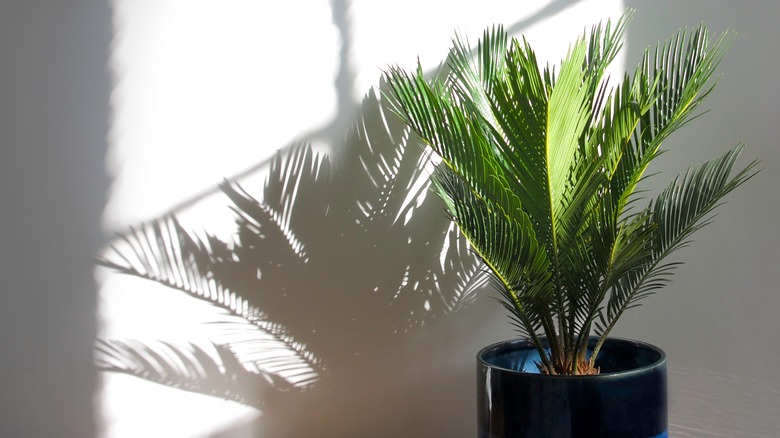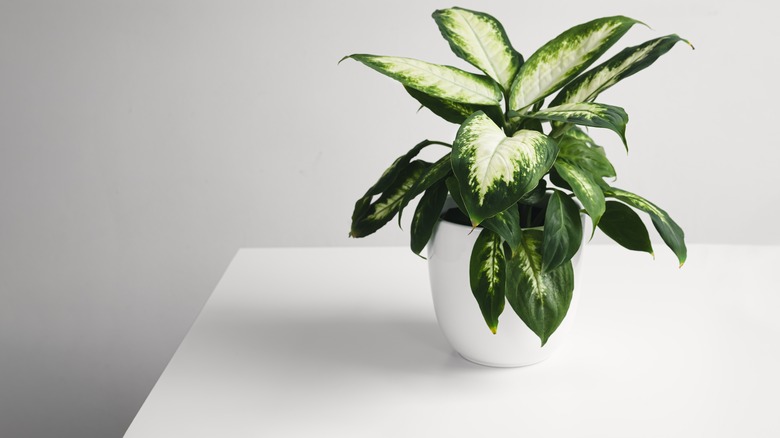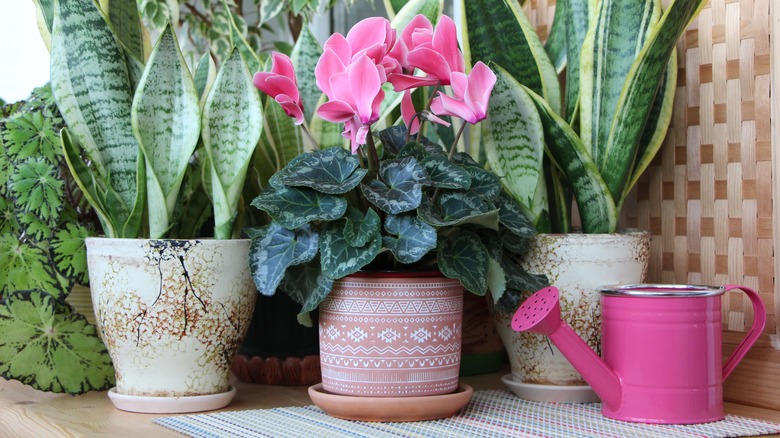House Plants You Should Never Grow In A Home With Pets
Houseplants add beauty and a touch of nature to your home, but buying the wrong plant can have detrimental results if you have pets. Pots Planters & More states the ASPCA Poison Control hotline answers about 150,000 calls each year about pets that have been accidentally poisoned, of which about 25% involve plant ingestion. While some toxic effects of plants are relatively mild, like vomiting or a burning sensation in the mouth, others are extreme and include seizures, heart damage, and death. Even if you think you can protect your pet from ingesting parts of a plant by hanging them, leaves can fall, and cats are excellent climbers.
For these reasons, it is best to avoid bringing these plants into your home altogether. There are so many beautiful plants safe for your beloved furry friend that you do not have to miss out on the benefits of house plants. To ensure every plant you bring into your home is safe, only buy options with labels identifying precisely what they are. Words like "fern" and "palm" can refer to many plants, some of which are safe and others toxic. Check the ASPCA Poisonous Plants list to ensure the greenery you buy is nontoxic for your pet.
Lilies
Although lilies (Lilium) are considered non-toxic to dogs, they are deadly to cats. According to the U.S. Food and Drug Administration, if a cat licks a bit of pollen off its coat, it can lead to kidney failure within three days. Every part of a true lily is toxic to cats, so even a nibble of a leaf or bloom should be treated as a medical emergency. If a cat does not get medical treatment within 18 hours of ingestion, it will likely have permanent kidney damage if it survives. Although peace lilies (Spathiphyllum) are not true lilies, they are toxic to cats and dogs, potentially causing oral irritation, vomiting, and difficulty swallowing.
If you want a plant in your home that offers big, bold blooms, consider getting a hibiscus (Hibiscus syriacus). These small bushes bloom profusely in the right conditions and are perfectly safe if your kitty takes a bite.
Oleander
Oleander (Nerium oleander) has gained popularity as a houseplant because of its beautiful blooms and attractive greenery. While it may be a stunning plant, it is highly toxic to cats, dogs, and humans. This is not a plant to have in the house if you have children or furry friends. Colorado State University notes that even a single dried leaf can be deadly if ingested by a small child. If eaten by a cat or dog, a small amount of oleander can cause severe heart damage, seizures, and death, states ASPCApro.
While they may not be as large and showy, African violets (Saintpaulia) are a non-toxic option that is safe for the whole family. These beautiful plants come in a variety of colors and shapes. The African Violet Resource Center says there are over 16,000 types of these plants, some of which are compact at about 8 inches tall, while others can grow up to almost two feet. With moderate light and moist soil, African violets can bloom year-round, making them an excellent alternative for Oleander in the home.
Sago palm
Although some types of palms are safe for pets, the sago palm (Cycas revoluta) is not. All parts of this plant are highly toxic to dogs and cats. VCA Animal Hospitals states that just a tiny bite of this plant can endanger a pet's life. The chemical compounds in the sago palm can cause problems with a cat or dog's nervous system, vomiting, and long-term liver damage if not treated immediately. Without treatment, liver failure will lead to a painful death within a few days. This pretty plant is certainly not worth the risk in a home with pets.
If you love the textured look of palm plants, consider a parlor palm (Chamaedorea elegans). These lovely plants may look exotic, but they are relatively easy to care for and are safe for pets who like to nibble, according to Earth's Ally. Parlor palms can grow up to 4 feet tall and tolerate low-light conditions, making them the perfect plant to add texture and interest to any space.
Dieffenbachia
Dieffenbachia plants are known for their bold foliage and tolerance of low-light conditions, but if you have a cat or dog that loves to chow down on your houseplants, this one is probably not ideal for your home. Unlike other plants on this list, dieffenbachia is unlikely to cause severe illness or death, but it can still cause great discomfort.
FirstVet compares the irritation from consuming the oxalate crystals contained in the leaves of this toxic plant to the feeling of eating fiberglass. In rare cases, consuming dieffenbachia can cause a cat's or dog's upper respiratory tract to swell, leading to breathing difficulties. Consider calathea plants as an alternative to dieffenbachia to get the bold, variegated leaf look without toxicity. Calatheas come in many shapes, sizes, and colors. These plants do best in bright, indirect sunlight but can tolerate lower lighting conditions. They make the perfect houseplant for you and your furry friends.
Cyclamen
Whole Pet Veterinary Clinic has cyclamen (Cyclamen persicum) on its list of 10 most poisonous plants. Although this houseplant's beautiful blooms and attractive foliage make it tempting to bring home, all parts of the cyclamen are toxic to dogs and cats. If a pet ingests just a tiny amount of cyclamen, the symptoms of toxicity should be mild and limited drooling, vomiting, or diarrhea; however, if they eat a lot of the plant, the results can be deadly.
This plant contains chemicals called saponins, which can cause heart problems like arrhythmia. Seizures are also possible after consumption; both of these symptoms can lead to death. The roots and tubers of cyclamen are particularly toxic to pets. Like the oleander, African violets are an excellent choice if you are looking for a safe plant alternative to cyclamen. With so many cultivars from which to choose, you can certainly fill your need for colorful flowers with a variety of African violets displayed around the house.
